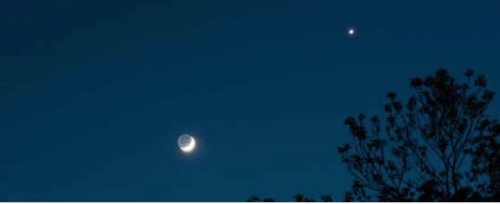When Venus, Moon break social distancing norms!
TDT | Manama
Experts say we are having a great season for planet-spotting, with most of the planets in the solar system putting up rare shows before naked eyes. Our region today morning provided planet hunters one such rare instance of the Venus and Moon getting together, or as we say, “breaking social distancing norms” that too before naked eyes! How dare, isn’t it? Yet, that happened! Astronomers call these events conjunctions.
In astronomy, a conjunction occurs when any two astronomical objects (such as asteroids, moons, planets, and stars) appear to be close together in the sky, as observed from Earth. Although the moon and Venus appear close together on the sky’s dome, they are not truly close together in space.
At the time that the moon swings by Venus, the moon will be very close to its average distance from Earth (238,855 miles or 384,400 km). The close encounter of the dynamic duo but was visible to naked eyes, thanks to Venus, also known as the “evening star, for being the third brightest object in the sky after the sun and moon.
Experts say Sharp-eyed people could pick up Venus in a daytime sky, as the moon is there to assist them. The trick is to find the moon first and then Venus. According to Majed Abu Zahra, Chairman of the Saudi Astronomical Society, the phenomenon in which Venus reigned as the brilliant “morning star” was observable from most Arab countries.
“The moon and Venus are the second and third brightest objects in the sky after the sun, so they are seen even after the sky becomes bright,” an AlAyam report quoted Abu Zahra as saying in an interview with Al Arabiya. He explained: “Using binoculars, we can see the arched line separating the illuminated and dark side of the moon and the three-dimensional view of the moon’s topography.”
“When you observe Venus through a telescope, it’s possible to see its disk illuminated 50.1 per cent thanks to the sunlight at this time of the year. “However, due to the movement of the planet in its smaller orbit around the sun, during the coming months, the disk of the Venus will get smaller as its distance from the Earth increase.
This will be accompanied by a gradual increase in the Sunlight illuminating the disk until it reaches its full moon phase and returns to the evening sky in late March of 2021,” he added. Explaining further, he said, “Venus is often known to people as the evening star” when it is seen at the evening sky, and as the “morning star in the morning sky.”
Ancient people, he said, believed for a long time that the morning star and the evening star were two different bodies, so they called them “Phosphorous” and “Hesperus”, but Pythagoras realised 500 years before that the two are the same. And Venus is likely to be the first planet known in this way because of its brightness and relatively rapid movement. ”
Related Posts

